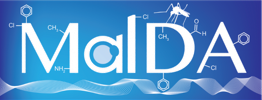Antiplasmodial peptaibols act through membrane directed mechanisms.
Journal:
Cell chemical biology, Volume: 31, Issue: 2Abstract:
Our previous study identified 52 antiplasmodial peptaibols isolated from fungi. To understand their antiplasmodial mechanism of action, we conducted phenotypic assays, assessed the in vitro evolution of resistance, and performed a transcriptome analysis of the most potent peptaibol, HZ NPDG-I. HZ NPDG-I and 2 additional peptaibols were compared for their killing action and stage dependency, each showing a loss of digestive vacuole (DV) content via ultrastructural analysis. HZ NPDG-I demonstrated a stepwise increase in DV pH, impaired DV membrane permeability, and the ability to form ion channels upon reconstitution in planar membranes. This compound showed no signs of cross resistance to targets of current clinical candidates, and 3 independent lines evolved to resist HZ NPDG-I acquired nonsynonymous changes in the P. falciparum multidrug resistance transporter, pfmdr1. Conditional knockdown of PfMDR1 showed varying effects to other peptaibol analogs, suggesting differing sensitivity.
